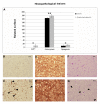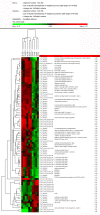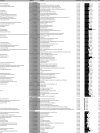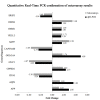Medulla oblongata transcriptome changes during presymptomatic natural scrapie and their association with prion-related lesions
- PMID: 22897917
- PMCID: PMC3495657
- DOI: 10.1186/1471-2164-13-399
Medulla oblongata transcriptome changes during presymptomatic natural scrapie and their association with prion-related lesions
Abstract
Background: The pathogenesis of natural scrapie and other prion diseases is still poorly understood. Determining the variations in the transcriptome in the early phases of the disease might clarify some of the molecular mechanisms of the prion-induced pathology and allow for the development of new biomarkers for diagnosis and therapy. This study is the first to focus on the identification of genes regulated during the preclinical phases of natural scrapie in the ovine medulla oblongata (MO) and the association of these genes with prion deposition, astrocytosis and spongiosis.
Results: A custom microarray platform revealed that 86 significant probes had expression changes greater than 2-fold. From these probes, we identified 32 genes with known function; the highest number of regulated genes was included in the phosphoprotein-encoding group. Genes encoding extracellular marker proteins and those involved in the immune response and apoptosis were also differentially expressed. In addition, we investigated the relationship between the gene expression profiles and the appearance of the main scrapie-associated brain lesions. Quantitative Real-time PCR was used to validate the expression of some of the regulated genes, thus showing the reliability of the microarray hybridization technology.
Conclusions: Genes involved in protein and metal binding and oxidoreductase activity were associated with prion deposition. The expression of glial fibrillary acidic protein (GFAP) was associated with changes in the expression of genes encoding proteins with oxidoreductase and phosphatase activity, and the expression of spongiosis was related to genes encoding extracellular matrix components or transmembrane transporters. This is the first genome-wide expression study performed in naturally infected sheep with preclinical scrapie. As in previous studies, our findings confirm the close relationship between scrapie and other neurodegenerative diseases.
Figures




Similar articles
-
Gene expression profiling and association with prion-related lesions in the medulla oblongata of symptomatic natural scrapie animals.PLoS One. 2011;6(5):e19909. doi: 10.1371/journal.pone.0019909. Epub 2011 May 24. PLoS One. 2011. PMID: 21629698 Free PMC article.
-
Gene and protein patterns of potential prion-related markers in the central nervous system of clinical and preclinical infected sheep.Vet Res. 2013 Mar 11;44(1):14. doi: 10.1186/1297-9716-44-14. Vet Res. 2013. PMID: 23497022 Free PMC article.
-
Correlation between Bax overexpression and prion deposition in medulla oblongata from natural scrapie without evidence of apoptosis.Acta Neuropathol. 2006 Oct;112(4):451-60. doi: 10.1007/s00401-006-0094-4. Epub 2006 Jun 28. Acta Neuropathol. 2006. PMID: 16804709
-
Reflections on Cerebellar Neuropathology in Classical Scrapie.Biomolecules. 2021 Apr 28;11(5):649. doi: 10.3390/biom11050649. Biomolecules. 2021. PMID: 33924986 Free PMC article. Review.
-
Influence of the prion protein gene, Prnp, on scrapie susceptibility in sheep.APMIS. 2002 Jan;110(1):33-43. doi: 10.1034/j.1600-0463.2002.100105.x. APMIS. 2002. PMID: 12064254 Review.
Cited by
-
Gene expression profiling of mesenteric lymph nodes from sheep with natural scrapie.BMC Genomics. 2014 Jan 23;15:59. doi: 10.1186/1471-2164-15-59. BMC Genomics. 2014. PMID: 24450868 Free PMC article.
-
Whole Blood Gene Expression Profiling in Preclinical and Clinical Cattle Infected with Atypical Bovine Spongiform Encephalopathy.PLoS One. 2016 Apr 13;11(4):e0153425. doi: 10.1371/journal.pone.0153425. eCollection 2016. PLoS One. 2016. PMID: 27073865 Free PMC article.
-
Transcriptome analysis of CNS immediately before and after the detection of PrP(Sc) in SSBP/1 sheep scrapie.Vet Microbiol. 2014 Oct 10;173(3-4):201-7. doi: 10.1016/j.vetmic.2014.07.026. Epub 2014 Aug 15. Vet Microbiol. 2014. PMID: 25183238 Free PMC article.
-
Gene expression profiling of brains from bovine spongiform encephalopathy (BSE)-infected cynomolgus macaques.BMC Genomics. 2014 Jun 5;15:434. doi: 10.1186/1471-2164-15-434. BMC Genomics. 2014. PMID: 24898206 Free PMC article.
-
The effect of PrP(Sc) accumulation on inflammatory gene expression within sheep peripheral lymphoid tissue.Vet Microbiol. 2015 Dec 31;181(3-4):204-11. doi: 10.1016/j.vetmic.2015.10.013. Epub 2015 Oct 17. Vet Microbiol. 2015. PMID: 26507419 Free PMC article.
References
Publication types
MeSH terms
Substances
LinkOut - more resources
Full Text Sources
Research Materials
Miscellaneous

